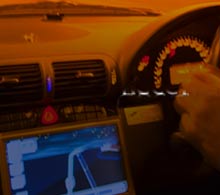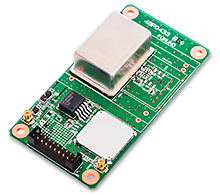Articles for ITS market Connected business potential and newly proposed "eMaaS" by Honda
The diversity of Connected Business
A new connected service was explained to media at the annual technical briefing session at the "Honda Meeting (July 3, 2019: Wako City, Saitama Prefecture)" hosted by Honda.
This is highlighted as a move towards a new service business that goes beyond the concept of connected cars that has currently been discussed in the automotive industry.
To clarify the word connected car includes various meanings. In general, it means connecting the in-vehicle system of the car to communication equipment and communication infrastructure via electrical signals using Wi-Fi, Bluetooth, or cellular telephone line.
Among them there is a link between smartphones and in-vehicle systems that Apple and Google (part of Alphabet) have advocated since around 2014. Apple promoted CarPlay and Google promoted Android Auto. This is referred to as infotainment as it relates to in-vehicle entertainment such as playback of audio / image content such as music, movies and television programs, SNS (social network service), etc. as they associate with information.
In infotainment, the battle for supremacy in the in-vehicle device operating system is intensifying and the percentage of Android OS by Google (part of Alphabet) has been expanding in recent years.
Among the Japanese manufacturers, Honda was the first to promote CarPlay, Android Auto and the transition to Android OS of car-mounted devices.
Alternately connected cars also have a big influence on automated driving. The term "connected" in this case refers to the conversion of vehicle location and travel information into “big data” through an external infrastructure. The aim is to improve the stability and safety of automated vehicle operation or Advanced Driver Assistance System (ADAS) through the next generation of high-precision three-dimensional maps, weather conditions and accident information. Communication between vehicles is called V2V, and communication with the road side infrastructure is called V2I, focusing on vehicles(V). V2X (V to X) is a more generic term for these.
Honda announced that it will commercialize Level 3 automated driving when traffic jams occur on Japanese highways in 2020. At level 3, the main control of automated driving shifts from the driver to the car system. Therefore until the driver is notified of "transition of driving" from the system of the car, "second tasks" such as reading in the car and use of a smartphone is permitted. V2X makes it possible to keep track of the driving mode situation.
In addition to the infotainment and V2X a new connected service "eMaaS" was announced at this Honda meeting.
New target business for eMaaS
 Mass-production EV "HONDA e", Japanese specifications correspond to CHAdeMO type charge
Mass-production EV "HONDA e", Japanese specifications correspond to CHAdeMO type charge
 Small-sized Electric Robot for Walking Assistance "3E-B18"
Small-sized Electric Robot for Walking Assistance "3E-B18"
eMaaS's “e” stands for energy service, and MaaS stands for mobility as a service.
he word MaaS has become popular in public transport in recent years. The concept is that open data will be created by sharing travel data such as trains, buses and taxis with an API (application programming interface) and a new business strategy including venture companies will be constructed. Collaboration between the government and private companies has been in full swing in Scandinavia, Germany, etc. since 2016-2017 and social implementation is progressing.
On the other hand, MaaS, which Honda defines in eMaaS, is characterized by its limitation as an electric vehicle produced by Honda. Honda has positioned the MaaS as a fuel cell vehicle, ultra-small mobility, and small robots for medical and nursing care, with the EV "HONDA e" scheduled to be released in Japan from this fall. For batteries it uses removable and portable MPPs (mobile power packs) for ultra-small mobility and small robots. Already Suzuki and Yamaha Motor have agreed on the standardization of batteries for electric mobility based on MPP.
On the other hand, the EaaS (Energy-as-a-Service) concept is used to define the mechanism of electricity distribution based on renewable energy.
And it is eMaaS that united EaaS and MaaS. By connecting electric mobility and energy services, Honda aims to "make life enjoyable and convenient and free of stress".
Can they go beyond smart grids?
According to the chart presented by Honda it shows eMaaS as a technical platform. In eMaaS the usage status including the running status from the electric mobility vehicle and the remaining battery capacity are collected. They will analyze it into “big data” and make a business that includes vehicle charging, charging infrastructure, power grid operators and power generators or power retailer solutions for a win-win.
I recall something similar to this model somewhere.
It's a "smart grid". When mass production of Nissan LEAF and Mitsubishi i-MiEV started around 2010, there was a movement to regard EV as a simple stationary battery and to integrate with the power network. Smart grid was a business area where major electric power companies such as Tokyo Electric Power, major gas companies such as Osaka Gas, and heavy electric power manufacturers such as Mitsubishi Heavy Industries entered the market.
However, after the Great East Japan Earthquake of March 11, 2011 nuclear power plants were expected to stop operation and not resume operation one after another. This caused Japan's electricity demand to rapidly increase the share of thermal power generation by liquefied natural gas (LNG). Also the debate over the use of renewable energy derived from solar and wind power has suddenly cooled. Among them there is a suggestion that the smart grid structure is also on hold.
This time however eMaaS, advocated by Honda is not a smart grid remake.
Instead it is backed by a business model that introduces the latest connected technology and enables early social implementation. In the Philippines and Indonesia the movement toward eMaaS realization is accelerating, with demonstration tests using Mobile Power Pack (MPP) already beginning.
In the future if there is an opportunity, I would like to report from the site of Honda’s eMaaS Social Demonstration.
Writer introduction

Mr. Kenji Momota Automotive journalist
His major is the world automotive industry and he is also familiar with the energy industry, IT and the aging society problem as the related fields. He acts around the world based in Japan and USA and writes for the general magazines, the technology journals and the automotive related media etc.
He is also commentator of motor race and world's motor show on TV program based on his career of the driver of Indy Racing League and NASCAR. In recent years, he has been covering about a paradigm shift from developed countries to developing countries, the motorized vehicle like EV and the telematics.
FURUNO ITS Journal
Click here for the latest articles after 2022 (in Japanese)2022
- The "realistic" self-driving roadmap shown by the Japanese government and a hands-on report on the latest Subaru EyeSight X
- Will FCVs (Fuel Cell Vehicles) Become Popular? ~New Movement in Toyota and Honda~
- The 'Complete' online sales of new cars start in Japan. Will this new way of buying cars take root?
- Many Firsts! On-Site Report from Tokyo Auto Salon 2022 - The author, who knows what goes on behind the scenes, looks back on 40 years of history. -
2021
- "Moving toward zero traffic fatalities for four-wheeled and two-wheeled vehicles globally in 2050" ~Experience on Honda's latest safety technologies~
- Tsuneishi Shipbuilding's building and DX, an exclusive visit to the main factory
- Japan's Smart City: New Moves toward Practical Use
- When will self-driving buses (service cars) be put to "full-scale" practical use?
- Utilization vehicle data during disasters
- Toyota-led Connected Technology to Transform Commercial Vehicle Business -From light trucks to large trucks and buses-
- Toyota enters the connected car "Personalization" business
- Japanese automakers' carbon-neutral strategies swept up in ESG investment
- Drive experience of the latest autonomous vehicle models and advanced driving support systems
- Will carbon neutrality accelerate the trend to strengthen LCA (Life Cycle Assessment)?
- Semiconductor shortage exposes realities of the automotive industry
- Online Autonomous Driving Contest Enhancing development of Human Resources
2020
- What happens to CASE when gas cars are banned in Japan?
- When will Flying Cars be launched?
- Expectation vs. reality:Autonomous Driving in Japan
- V2X, Becoming increasingly important in autonomous driving
- Technology of Subaru “EyeSight X”
- Lifestyle-oriented French cars gain popularity in Japan
- Human-oriented smart cities are wanted
- MaaS and CASE, how would automotive industry change after COVID-19?
- The beginning of virtualization era, triggered by COVID-19
- Trend of EV shift and consumer demands
- TOYOTA Press conference about ADAS - Releasing algorithm for "sudden acceleration suppression during attempted sudden acceleration" free of charge -
- The Japanese automotive industry in 2020 - 3 turning points -
- "Using a smartphone while driving" and "Level 3 automated driving"
2019
- Motor show business model is at a turning point - Tokyo Motor Show Report -
- Commercialization and monetization of MaaS - ITS World Congress Singapore Report -
- Android Automotive pays attention to V2X - Report from the Frankfurt Motor Show 2019 in Germany -
- Automobile Distribution Revolution and DCM (Data Communication Module)
- Connected business potential and newly proposed "eMaaS" by Honda
- 5G services for practical use are multiplying
- Connectivity technologies attracting attention due to frequent traffic accidents
- Shanghai Motor Show report -SUV, EV, Automated car & 5G-
- Drone Business roadmap and updates to Michibiki (Quasi-Zenith Satellite System)
- MaaS (Mobility as a Service) "town development." Full-scale promotion for a national project
- CES organizer states "Data Period in 2020s." Transformation of the Automotive Industry in CES, US "-CES2019 Report-"
- "Return to Origin" directed towards the age of change, automatic operation and connectivity
2018
- New proposal for Private Car Automated Driving Level and other Hot 5G Technology Topics
- Standardized EV charging infrastructure concerns in Europe, US, Japan and China - Kobe EVS 31 field report -
- Touring a pure car carrier and a test drive of the latest hybrid car
- Planning stage products are exhibited at the newly established visualized mobility service "TOYOTA MOBILITY SHOWROOM".
- Potential “Community Car-share” program promoted by local residents
- CES Asia Report 2108
- Companies attempt new Vehicle-to-Infrastructure communications, including traffic volume measurements and vehicle positioning. -ITS Asia Pacific Forum in Fukuoka-
- Geneva show in Switzerland. Flying cars and MaaS (Mobility as a Service) were hot topics.
- EV (Electric Vehicle) proposals by country
- MaaS competition through service mobilization, M & A and technical field collaboration is accelerating. - The CES 2018 Report -
2017
- Big data’s initiative and fight for the automotive industry. Cooperation among companies becomes increasingly important.
- Connected car and road-to-vehicle communication automatic operation
- ETC (Electronic Toll Collection) and ETC2.0. Current situation and projected future
- Rapid development of sharing economy
- Germany is first to recognize level 3 automated driving
- ITS EU 2017 Field Reports -Automatic Operation and the eCall-
- From Infotainment to ITS, the competitive area is spreading in the car big data industry.
- GTC (GPU Technology Conference) Report and the de facto standardization of AI (artificial intelligence)
- Renesas' new challenge! "e-AI Solution" and "Renesas Autonomy"
- The Automobile industry is shifting from a manufacturing industry to a service industry.
- The movement toward accident countermeasures for aging drivers in Japan
- Fusion of ride sharing and fully automated driving is advancing in the USA.
2016
- Overview of the Quasi-Zenith Satellite System (QZSS) and advancements toward full-scale practical use including the Tokyo Olympic Games - G-space EXPO 2016 report-
- Japan’s automated driving project "SIP-adus" will be a large demonstration experiment.
- The International Home Care & Rehabilitation Exhibition. There were many car manufactures with exhibits booths at this show.
- Japanese car manufacturers starting to concentrate on strengthening the ADAS system
- A new movement of legislation for autonomous cars
- Cyber Security and “AGL”, the new OS for automotive are hot topics in the connected car industry
- “High precision 3D map” the key future of autonomous car and pedestrian dead reckoning
- Chinese “BAT” is accelerating their business in the EV (Electric Vehicle) market
- Tesla's original connection to Taiwan and the new transportation system technologies.
- "The main topic" of the Geneva Motor Show was how to strengthen "pedestrian protection"
- The probe data business is getting more competitive
- Reporting directly from the 2016 CES show "Data services will soon become the main revenue source of automotive industry"
2015
- Do the automated driving systems need the GNSS (Global Navigation Satellite System) ?
- ETC Version 2.0 is coming soon. A new service was announced at the Tokyo Motor Show and the possibility that is could be used as a device for older drivers.
- "Connected Horizon" and "eHorizon". Germany's leading parts supplier accelerates strengthening of "Big Data" for business



 Ultra-small mobility using MPP
Ultra-small mobility using MPP MPP Replacement Charger
MPP Replacement Charger They adopt charge system using streetlight of town.
They adopt charge system using streetlight of town. GPS/GNSS Receiver&Chips and Modules (positioning and timing)
GPS/GNSS Receiver&Chips and Modules (positioning and timing)